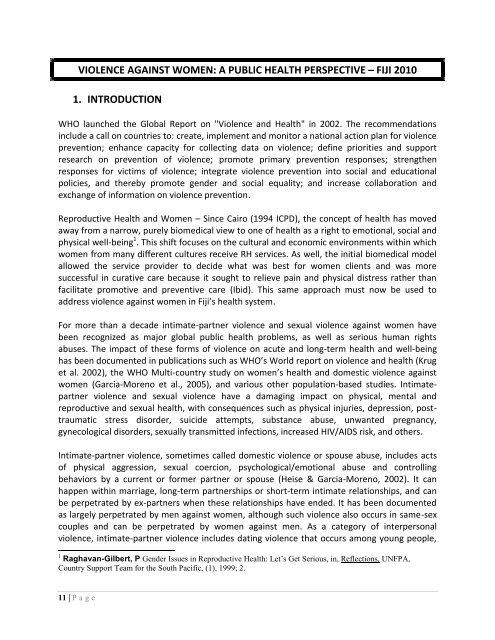Project Report â Fiji 2010 - Pacific Health Voices
Project Report â Fiji 2010 - Pacific Health Voices
Project Report â Fiji 2010 - Pacific Health Voices
Create successful ePaper yourself
Turn your PDF publications into a flip-book with our unique Google optimized e-Paper software.
VIOLENCE AGAINST WOMEN: A PUBLIC HEALTH PERSPECTIVE – FIJI <strong>2010</strong><br />
1. INTRODUCTION<br />
WHO launched the Global <strong>Report</strong> on "Violence and <strong>Health</strong>" in 2002. The recommendations<br />
include a call on countries to: create, implement and monitor a national action plan for violence<br />
prevention; enhance capacity for collecting data on violence; define priorities and support<br />
research on prevention of violence; promote primary prevention responses; strengthen<br />
responses for victims of violence; integrate violence prevention into social and educational<br />
policies, and thereby promote gender and social equality; and increase collaboration and<br />
exchange of information on violence prevention.<br />
Reproductive <strong>Health</strong> and Women – Since Cairo (1994 ICPD), the concept of health has moved<br />
away from a narrow, purely biomedical view to one of health as a right to emotional, social and<br />
physical well-being 1 . This shift focuses on the cultural and economic environments within which<br />
women from many different cultures receive RH services. As well, the initial biomedical model<br />
allowed the service provider to decide what was best for women clients and was more<br />
successful in curative care because it sought to relieve pain and physical distress rather than<br />
facilitate promotive and preventive care (Ibid). This same approach must now be used to<br />
address violence against women in <strong>Fiji</strong>’s health system.<br />
For more than a decade intimate-partner violence and sexual violence against women have<br />
been recognized as major global public health problems, as well as serious human rights<br />
abuses. The impact of these forms of violence on acute and long-term health and well-being<br />
has been documented in publications such as WHO’s World report on violence and health (Krug<br />
et al. 2002), the WHO Multi-country study on women’s health and domestic violence against<br />
women (Garcia-Moreno et al., 2005), and various other population-based studies. Intimatepartner<br />
violence and sexual violence have a damaging impact on physical, mental and<br />
reproductive and sexual health, with consequences such as physical injuries, depression, posttraumatic<br />
stress disorder, suicide attempts, substance abuse, unwanted pregnancy,<br />
gynecological disorders, sexually transmitted infections, increased HIV/AIDS risk, and others.<br />
Intimate-partner violence, sometimes called domestic violence or spouse abuse, includes acts<br />
of physical aggression, sexual coercion, psychological/emotional abuse and controlling<br />
behaviors by a current or former partner or spouse (Heise & Garcia-Moreno, 2002). It can<br />
happen within marriage, long-term partnerships or short-term intimate relationships, and can<br />
be perpetrated by ex-partners when these relationships have ended. It has been documented<br />
as largely perpetrated by men against women, although such violence also occurs in same-sex<br />
couples and can be perpetrated by women against men. As a category of interpersonal<br />
violence, intimate-partner violence includes dating violence that occurs among young people,<br />
1 Raghavan-Gilbert, P Gender Issues in Reproductive <strong>Health</strong>: Let’s Get Serious, in, Reflections, UNFPA,<br />
Country Support Team for the South <strong>Pacific</strong>, (1), 1999; 2.<br />
11 | P a g e
















